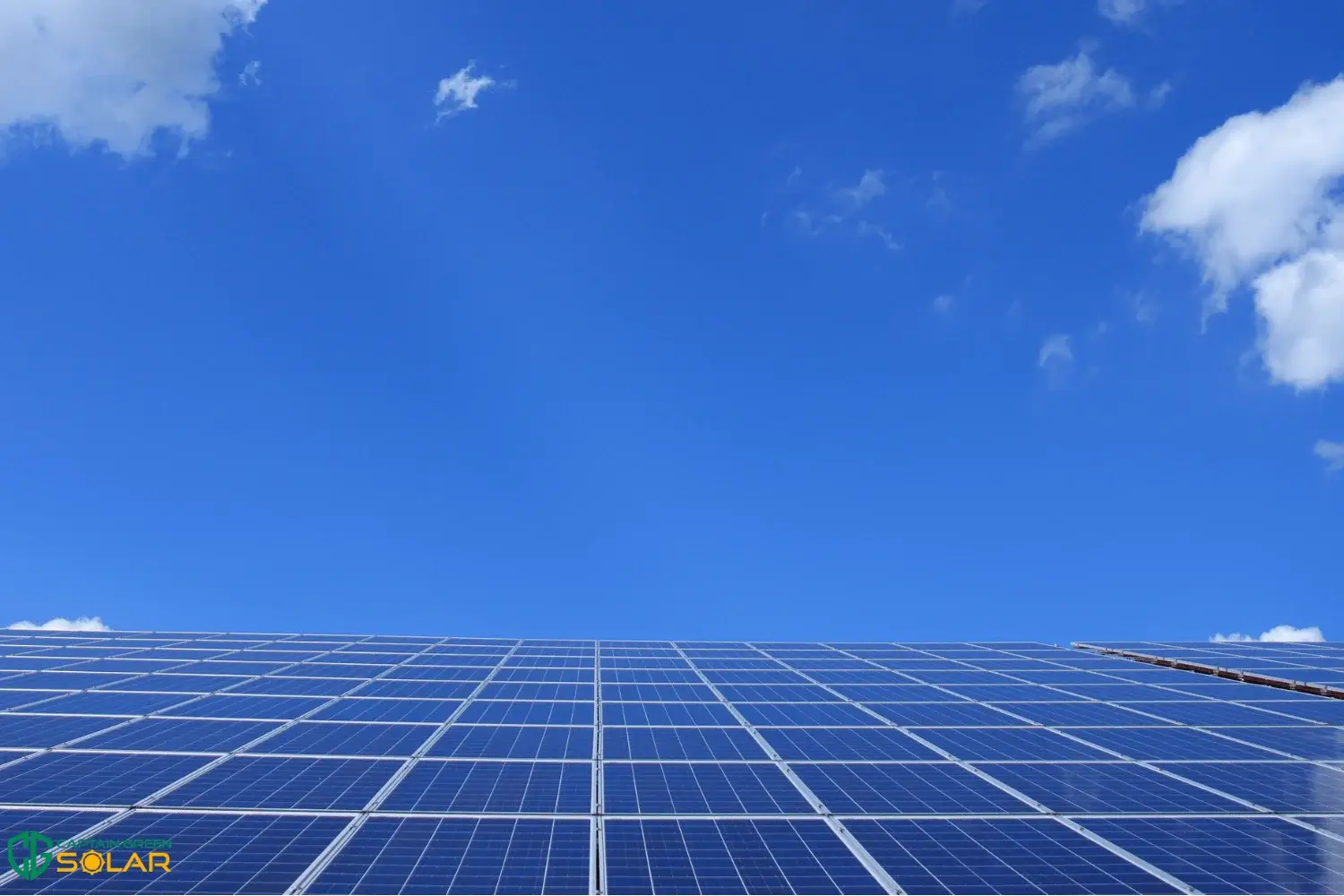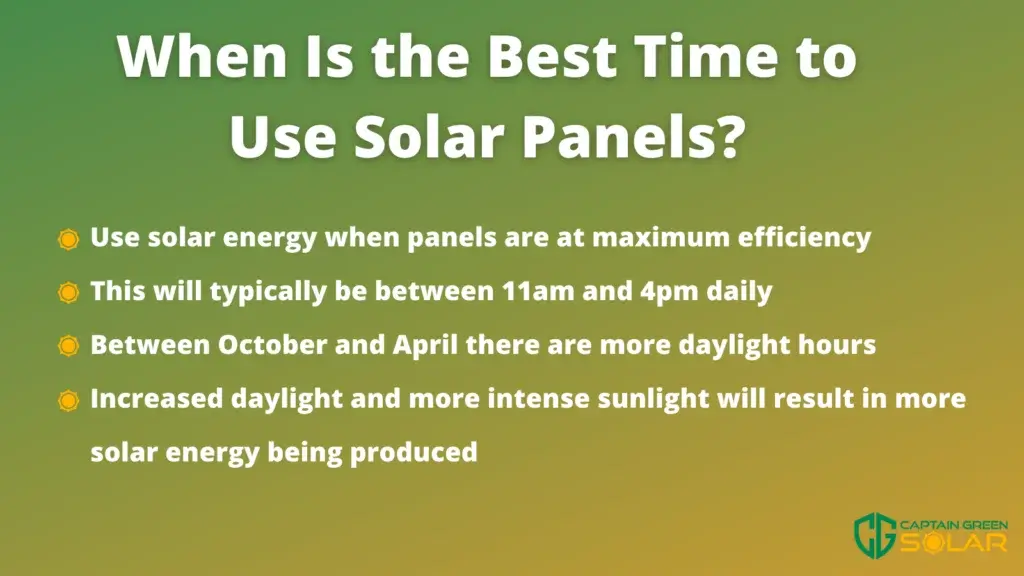ENTER YOUR POSTCODE TO UNLOCK SPECIAL

Whether you’re looking to invest in solar panels or you’re interested in getting the most out of your existing system, it’s important to understand and get to know what is the best time to use solar power.
Figuring out the best way to use solar power at home can be a challenge with so many factors to consider. Not to mention, with an abundance of conflicting information and advice online it can be overwhelming trying to take it all in. Fret not – in this article the experts at Captain Green are going cover what is the best time of day for solar panels, as well as the best time to use solar electricity. Once you’re across these concepts, you’ll be pleasantly surprised by just how much you can get out of your solar powered home with a few simple tweaks.
Let’s keep it simple and start by discussing the time of day that your panels are generating the most amount of electricity. After all, the time of day wherein your solar panels are the most effective, will translate to the most efficient time to be using that energy.
Solar systems rely on the sun and work best when there is plenty of sunlight to absorb. As the strength and angle of the sun changes throughout the day, so does the amount electricity your panels can generate throughout the day.
In the morning, whilst it may be sunny, the intensity of light is at its lowest. As the day progresses, between the hours of 11am and 4pm, the amount of solar radiation will be at its greatest. In return, so will the generation of energy from your panels. As the afternoon progresses into the evening, the intensity of light will diminish and when the sun goes down solar power generation will be nill. So, generally speaking, the best time of day for solar panels will be between 11am and 4pm. However, the exact hours and timings will slightly vary depending on where you live and the time of year.
When considering “what is the best time to use solar power?”, it’s also important to think about the various seasons each year and the weather impacts power generation.
Throughout the year, as the angle and amount of sunlight throughout the day changes, so will the output of your solar panels. In summer, the days are longer and there is typically more sun than any other months; particularly when compared to winter. Generally, we will see the highest power production for solar panels in the months between October and April. Note that this is for areas in the Southern Hemisphere such as Australia. In the Northern Hemisphere, this would work in reverse.
Although it is generally true that the more sunlight a solar panel receives, the more electricity it will produce, there are a few instances wherein this not the case.
We know that in the months between October and April, we will typically see longer hours of daylight and a higher rate of solar radiation, which increases the amount of electricity solar panels will generate. Typically, the best time of day for solar panels will be in the peak hours of the days in these months.

However, these warmer months also bring with them increasing temperatures. Over a certain temperature, solar panels see reductions in their overall efficiency.
Most PV solar cells are tested at 25 degrees when measuring their efficiency. As these panels are constructed with glass and metal framing, they can get extremely hot when in direct sunlight (think about how hot your car gets when sitting in the sun). The losses in efficiency will depend on the specifications of your panel.
Manufacturers should outline this rate as a temperature co-efficient. This is the percentage loss per degree Celsius above 25 degrees or other identified testing temperature. To explain further, let’s run through a quick example.
Let’s say your solar panel operates at an efficiency of 20% at 25 degrees Celsius and has a temperature co-efficient of -0.5%.
When your solar panel hits 26 degrees, its total efficiency would be reduced by 0.5% to 19.9%. If the panel was to reach 33 degrees, it would operate at 19.31%. Most solar panels operate on a temperature co-efficient between 0.2-0.5%. In Australia, panels can reach temperatures of up to 65 degrees in summer.
So, whilst this percentage may seem small, it can result in a substantial reduction when compounded at higher temperatures.
All in all, whilst your panels may produce less energy during the cooler winter months, they will remain efficient in the cooler temperatures and still provide you with an adequate amount of energy.
The orientation of your panel will also determine what is the best time to use solar power, in terms of energy production as well as the number of hours it is operating at its maximum efficiency.
The orientation of your panels will be dependent on where you live and the architecture of your roof (if your panels are mounted on your roof). The majority of panels in Australia are most efficient when installed facing north, at an angle of 20-30 degrees. As Australia is in the Southern Hemisphere, the sun is mostly directed from the north. Panels may also be angled slightly to the West or East to increase coverage and optimal generation throughout the day. Panels may be reduced to an angle of 10 degrees if needed; however, most installers will maintain a pitch of at least 10 degrees so panels can self-clean, and leaves will fall off when it rains.
Ensuring the best orientation for you household can make a significant difference in the long run. That’s why it is important to consult with a qualified solar installation company such as Captain Green Solar to ensure you’re maximising your investment into solar energy.

Now that we’ve looked at what makes solar panels most efficient throughout the day, let’s look at what is the best time to use solar power. Unless you have a solar battery storage system, once the sun goes down, you will lose most of your solar energy created throughout the day. So, let’s break down further how to make the most of all of that energy that your panels are producing.
When they are at peak output.
While the tips below will help you increase your energy efficiency and make the best use of your solar power throughout the day, the most fundamental step is figuring when your solar panels will produce the most energy. You can determine this in a number of ways, depending on how your solar system is setup and the type of products that you’re using. Some models may have a display screen connected to the inverter whilst other companies provide you with this data online through. If you are unsure how to access this information, you can always contact a solar panel technician who will be able to assist you. Using this information is key in determining what is the best time to use solar power in your home. Here are some tips for getting the most out of your solar panel set up :

When trying to make the most of any energy system, efficiency is key. Try to use appliances, lights and fittings that are rated to high energy standards to get the most bang for your (solar powered) buck.
What is the best way to use solar power at home? Use timed appliances. If your appliances have timers or you are home throughout the day, turn them on when your system is producing the maximum amount of energy. For example, if your system produces a significant amount of energy in the earlier parts of the day, set your dishwasher and washing machine to begin before you leave for work.
What is the best time to use solar power for heaters and air conditioners? The best time to use solar electricity for heating and cooling is when you need it. If you are out during the day or not using an area of your house, turn off the air-conditioning. Additionally, keep temperatures within a controlled range to maximise efficiency
If you have lots of devices or cordless appliances, what is the best time to use solar power for charging? The middle of the day. Just like with your other appliances, charging your devices during the daytime will help maximise the utility of your solar panels.
If you need further assistance working out what is the best time to use solar power for your property, or you have any other solar related enquiries, feel free to get in contact with the Captain Green Solar team on 1300 361 682.

Captain Green Solar is one of the Top Solar Companies in Australia. Established in 2010, we are the Trusted Name in Solar for over 14 Years!

Captain Green Solar is one of the Top Solar Companies in Australia. Established in 2010, we are the Trusted Name in Solar for over 14 Years!
